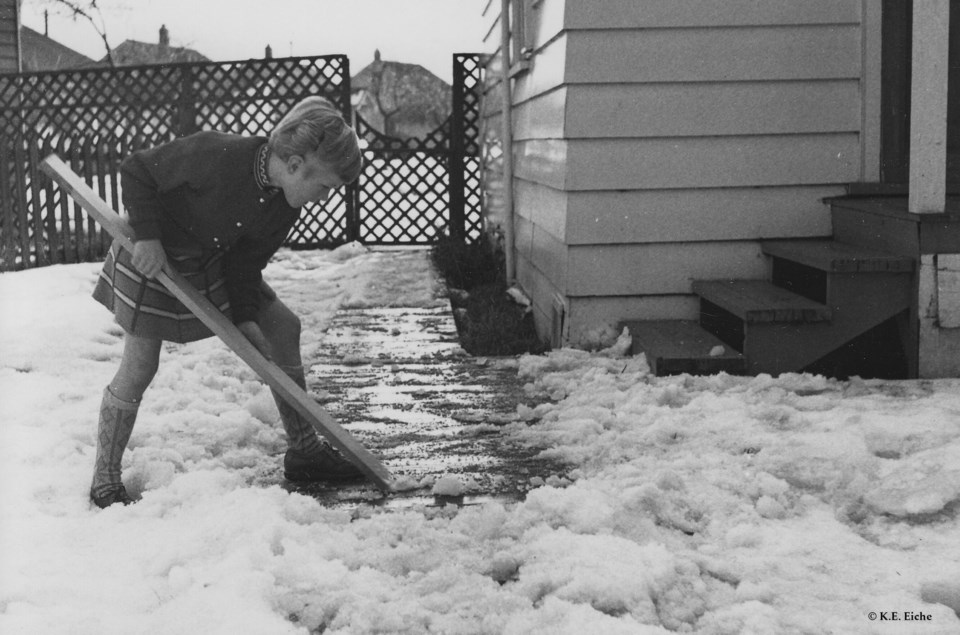The first winter we spent in Richmond as new immigrants from Germany was that of December 1956 to March 1957. We’d arrived in October 1956 and lived in Burkeville. I was enrolled in Grade Two at Sea Island School, located in the R.C.A.F. Annex. It was quite a walk from our house on Douglas Crescent. At the beginning of 1957, we had snow. My mother dressed me in brand new woolen slacks that she’d bought in Germany. I was sent home with a note from the teacher. Girls were not allowed to wear slacks to school. Girls had to wear skirts.
My parents were outraged. It was freezing outside and I was not permitted to be warmly dressed. In fact, they were so angry at what they thought was a senseless rule that my father took a photograph of me scraping the snow off the sidewalk in our back yard, wearing the clothes I wore to school after we were informed that girls were to dress in skirts not slacks. The photograph was intended for the family back home in Germany so that they, too, would be shocked by the unenlightened attitude of the local school board.
I was reminded of this incident – being told I was inappropriately dressed for school – when I read what had happened to a Grade Twelve student in Kamloops in 2021. The seventeen-year-old girl was sent home from school because of her outfit – a white turtleneck under what she called a black dress, but what looked, with its spaghetti straps and lace trim along the top and at the hem, not to mention its snug fit, an awful lot like a slip, a ladies’ undergarment that’s gone out of fashion. The black dress-slip allegedly made the teacher and a male student teacher feel uncomfortable.
Protests ensued. The student claimed she wasn’t aware of what a slip was, or that it was considered lingerie, which she associated with “something sexual.” Had she, or her father, who was also incensed, done a bit of research they would have discovered that two and a half centuries earlier a slip referred to a sleeveless outer garment, which was called a slip because it was easily slipped on and off. The word for sleeve is related etymologically in so far as the sleeve is the part of the garment into which the arm slips. And let’s not forget that for a very long time sleeves were separate pieces of clothing and that your sleeves would be attached to your garment once you were wearing it. You did literally slip your sleeves on and off your arms.
When I searched online for Richmond School District’s dress code (Policy 502.1.2), I found only two pages of administrative guidelines that had been adopted in 2004, and a half page entitled “policy”, which was not dated. The administrative guidelines state that ”Clothing should demonstrate the self-respect and dignity of the wearer. At a minimum, clothing should not be immodest. For secondary students, while there is neither need for nor benefit to formality, clothing should meet the minimal standards of propriety that are typical of the workplace.” But what are the “minimal standards of propriety ... typical of the workplace”? Are they thinking of the workplace of techies, where the wannabe Mark Zuckerbergs don hoodies and jeans? Or what? It would be interesting to know.
The information in the half-page dress code policy is vague and open to interpretation, perhaps intentionally so since it’s stated that “The correct balance between individual liberty, social convention, functionality, and context in matters of dress is impossible to define precisely.”
It was certainly simpler in the 1950s. I don’t think there even existed “Articles of clothing that promote alcohol or drugs, that display offensive language or images, or that encourage racism or bigotry”, which of course are unacceptable in a school. The dress code when I went to school could be summed up in four words – girls' skirts, boys' pants.
Sabine Eiche is a local writer and art historian with a PhD from Princeton University. She is passionately involved in preserving the environment and protecting nature. Her columns deal with a broad range of topics and often include the history (etymology) of words in order to shed extra light on the subject.



